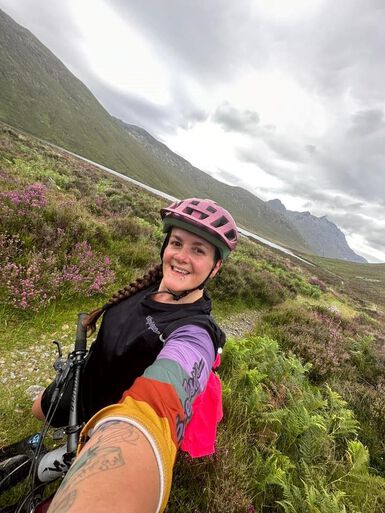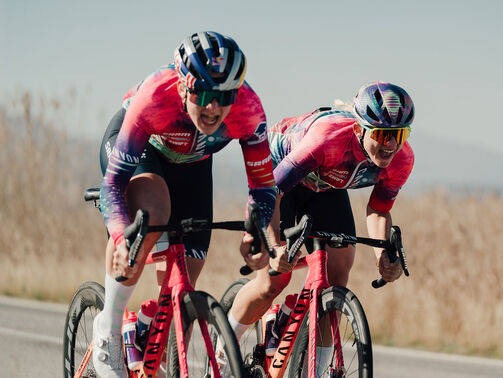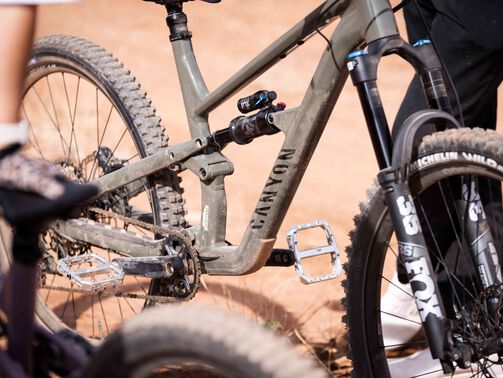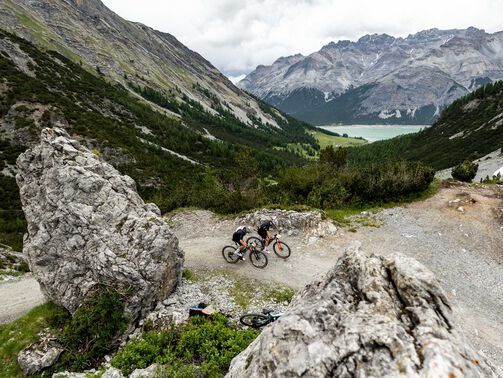Enduro MTB racing explained: Detailed guide
Combine the technical skill of gravity racing, with the fitness and stamina of cross country mountain biking and you get enduro racing. Here’s everything you need to know about this lung-busting, adrenaline-packed race format that takes its inspiration from motorbike enduro.


The aim of enduro racing is simple: get you and your bike to the top of a mountain or trail, and ride back down as fast as you can. Downhill stages are timed, uphill transfers between them are untimed, and the rider with the shortest cumulative downhill stage time wins.
In this guide, we delve into more detail on enduro mountain biking including how it started, how races work and which major global enduro events to follow, with training tips for riders.
Contents
Introduction to enduro MTB racing: Origins and evolution
The roots of enduro mountain biking can be traced back to 2003 in Val d’Allos, a ski village in the French Alps. Fred Glo’s Tribe 10000 event was the first mountain bike race to be called ‘enduro’ – a multi-stage, adrenaline-fuelled weekend event with 10 timed all-mountain and downhill stages, and chair lifts in between.
It was the birth of an exciting new long-form race format, blending the technical skill of downhill with the fitness of cross country, evolving quickly into one of the most popular mountain bike disciplines across the world.
By 2008, the burgeoning, grassroots-led enduro racing scene had spread to Italy in Franco Monchiero and Enrico Guala’s Superenduro series, with pedal-powered uphills to suit the terrain.
Across Europe the local amateur scene thrived and in 2012 the Enduro World Series (EWS) was launched by ex downhill pro and former UCI commissioner Chris Ball. The series had support from the Enduro Mountain Bike Association (now British Enduro Mountain Bike Association, BEMBA) and the first EWS season kicked off in 2013 in Tuscany.
Spectator viewing and broadcasting was soon introduced and by 2023, EWS became the UCI Mountain Bike Enduro World Cup (EDR) as the UCI officially took over, also launching the first ever UCI Enduro World Championships in 2024. Alongside the new EDR series, World Champs, and British Cycling National Enduro Championships, the grassroots heart of enduro biking is still beating, with several UK, European and global amateur enduro events of all sizes, including 25 events across 21 different countries which act as qualifiers for Enduro World Cup races.
Understanding race formats in enduro MTB
Most enduro mountain biking events have up to six timed, mostly downhill stages across a day or two, with varying steepness, terrain and difficulty. Day one is usually practice day. The downhill stages are timed, and the uphill transfers between them (called liaisons), are untimed, but you do usually have a cut off time to get to the start of each stage.
Exactly how you get to them will vary depending on the race location and elevation change between stages: either pedal power, van uplift or chair lift if it’s an off-season ski resort.
At the start of each stage, riders are sent off individually in timed intervals, and it’s you against the clock. Races usually start with a transfer to the top of the first stage and end on a final descent. After completing all downhill stages you get a cumulative time and race positioning, and the shortest total time wins. If the race is part of a series, there’ll be individual race winners and for some series’, an overall winner.
Depending on the terrain and race location, you’ll either be riding for a couple of hours in total or more than six, on difficult climbs and long, technical descents – so it’s worth looking this up before you start training to know what you’re in for!

Bike facts: The anatomy of an enduro mountain bike
Although you don’t strictly need a specific enduro bike to be able to ride or race enduro, it’ll definitely make things more efficient. Canyon enduro bikes are built for maximum downhill performance and the power to pedal back up to the top, keeping you comfy and switched on for a day of up-down repeats.
Geometry
Like downhill bikes, enduro bikes have a long wheelbase, long reach and slack head tube angle of around 63-64° for stability at speed on steep descents. A steeper seat angle of around 76° (vs 63-66° for downhill), is what gives the bike its pedal power, positioning the rider more forwards over the bike. Big hits need decent brakes so enduro bikes have big rotors and powerful pads for reliable stopping power in all conditions.
For optimum performance, the race-winning Canyon Strive CFR has adjustable geometry, using Shapeshifter technology to switch between Shred Mode and Pedal Mode at the flick of a dial. Following the Canyon Strive enduro mountain bikes, the Canyon Torque stands out as an exceptional choice for enduro MTB racing. Built for aggressive terrain and steep descents, it delivers unmatched stability and responsiveness.
Suspension
Enduro bikes typically have 160-180mm front and 160-170mm rear suspension travel to soak up big downhill hits and technical terrain. Single crown forks (opposed to dual crown on downhill) make technical climbing easier with more manoeuvrability.
Wheels and tyres
Enduro bikes come with 29 or 27.5 inch wheels – 29ers offering better rollover on rough terrain, 27.5 increasing manoeuvrability, or a mullet set up (29 front, 27.5 rear) bringing the best of speed, traction and agility.
Thick tyres with deep contrasting tread prevent punctures and increase traction. The sacrifice in rolling speed is made up for in predictability on rough, steep descents, and that’s what really matters when you’re racing enduro.
Drivetrain and gearing
A 1x12 drivetrain with a single front chainring and no front derailleur saves weight, simplifies shifting and reduces clatter on technical trails. The ‘dinner plate’ cassette brings the easier gears for climbing.
Go deeper on the differences between downhill and enduro bike geometry, and read our Enduro Bike Buyer’s Guide.

What to know about training for enduro MTB racing:
When it comes to training for enduro mountain biking (whether you’re racing or not), the clue’s in the name: enduro = endurance. Training should cover four core elements: endurance to keep you riding all day, strength and power to push hard on the descents, high intensity for speed, and bike skills for the techy bits (of which there are many!).
Make sure you check out your event’s total distance and elevation so you know what to expect and can build your training plan to fit.
Endurance training
All-day racing needs a solid base fitness and the best way to build that is with lots of low intensity, zone two aerobic training. Time on the bike, at an easy conversational pace, even on the hills. Mix up your weekly rides to include shorter rides of an hour or so and at least one longer ride of three hours or more (check the total riding time of your event) to build endurance.
Get comfy riding hills during training so you’re comfy on race day, where pedal efficiency is the name of the game. Nice easy rhythm up the climbs (active recovery!),and save your energy to ride as fast as you can for the timed downhills.
Remember, endurance training doesn’t have to all be on the mountain bike – road, gravel and turbo training all goes in the bank! If time is tight, build it into your day – a cycle commute is a great way to fit in extra training.
Strength and power training
A strong body will keep you powering up the climbs and solid on rough descents so make sure your weekly enduro race training includes at least two strength sessions.
Compound movements working multiple muscle groups and joints: squats, deadlifts, lunges, step ups, single leg romanian deadlifts (RDLs) for the legs. Upper body (press ups, bent over rows, bench press, pull ups) and core (Russian twists, dumbbell plank row, dumbbell plank pull through) for a solid and stable all-day riding position.
Tip: High weight, low reps to build power.
High intensity training
Interval sessions are the best way to train for race-day speed – short hard efforts followed by recovery, repeated several times. You can do this outdoors on the trail or on a hill, or indoors on a turbo or spin class.
A good time structure to follow would be 30 seconds hard, 30 seconds recovery, and push hard on the effort. Intervals are definitely type two fun, but if done properly, will get you fit, quick.
Tip: Timed enduro stages begin with a standing start so you’ll need to quickly get up to speed, and maintain the pace for the whole descent. Practice standing starts on the trail (being mindful of other riders).
Technical skills
Enduro stages are typically on rough, technical, mostly downhill trails, so practising your technical trail riding skills is essential to feel confident and enjoy the race. Expect roots, rocks, drops and technical twists and turns, rideable at speed, for those who can.
Every event course will be open for practice runs so you won’t go into it blind, but the more riding you can do beforehand (sessioning trails you struggle with is a good idea), the better prepared you’ll be to take on the tech descents.
Major enduro MTB events around the world
Enduro captures the spirit of all that’s great about mountain biking – big days out on the bike with your mates, riding up and down hills, trying to beat each other on the descents – and packages it up into a fun* and friendly race format that everyone can have a go at. At the core of enduro racing is its unique participatory element, giving amateur riders the unique opportunity to race on the same track as the pros during some of the same weekend events.
- UCI Enduro World Cup (EDR) - The biggest enduro series, formerly Enduro World Series, with events across Europe and Tasmania including Loudenvielle (France), Leogang (Austria) and Bielsko-Biala (Poland).
- British National Enduro Series (BNES) - A collection of events across some of the best riding spots in the UK by race organisers affiliated with the British Enduro Mountain Bike Association (BEMBA). 2024 is the seventh year of the BNES, with six individual events including the Manx MTB Enduro (Isle if Man), Welsh Champs (White Rocks / Machynlleth), Southern Enduro (Minehead) and sadly the last Tweedlove events in Scotland’s Laggan and Innerleithen.
- Ard Rock, Yorkshire Dales - Legendary UK mountain bike festival with onsite camping, pump track, airbag, music and entertainment alongside the racing.
- Malverns Classic, Hertfordshire - Another epic UK mountain bike festival with racing for all ages and disciplines, aka the ‘biggest party in British mountain biking’.
- Welsh Enduro Series - five rounds showcasing the best riding venues in Wales including Dyfi Forest, Mach & White Rocks, Llandegla and Llangollen.
- Big Mountain Enduro - Six rounds across North America.
- New Zealand Enduro Series - newly launched in 2024, six-event series will run from November 2024 to April 2025 with the series finale in Nelson.
- Crankworx Enduro - Whistler - An OG fixture in the global enduro calendar.
- Stone King Rally - Formerly Trans-Provence - hailed as the ‘world’s toughest mountain bike race’, a six-day enduro event with 24 stages traversing the French Alps.
Discover our Gravel Bikes
Did this article help?
Thank you for your feedback
-
 About the author
About the authorTess Agnew
Tess is a freelance copywriter, social media and communications pro based in Brighton with a passion for the outdoors and the mental health benefits it brings.








